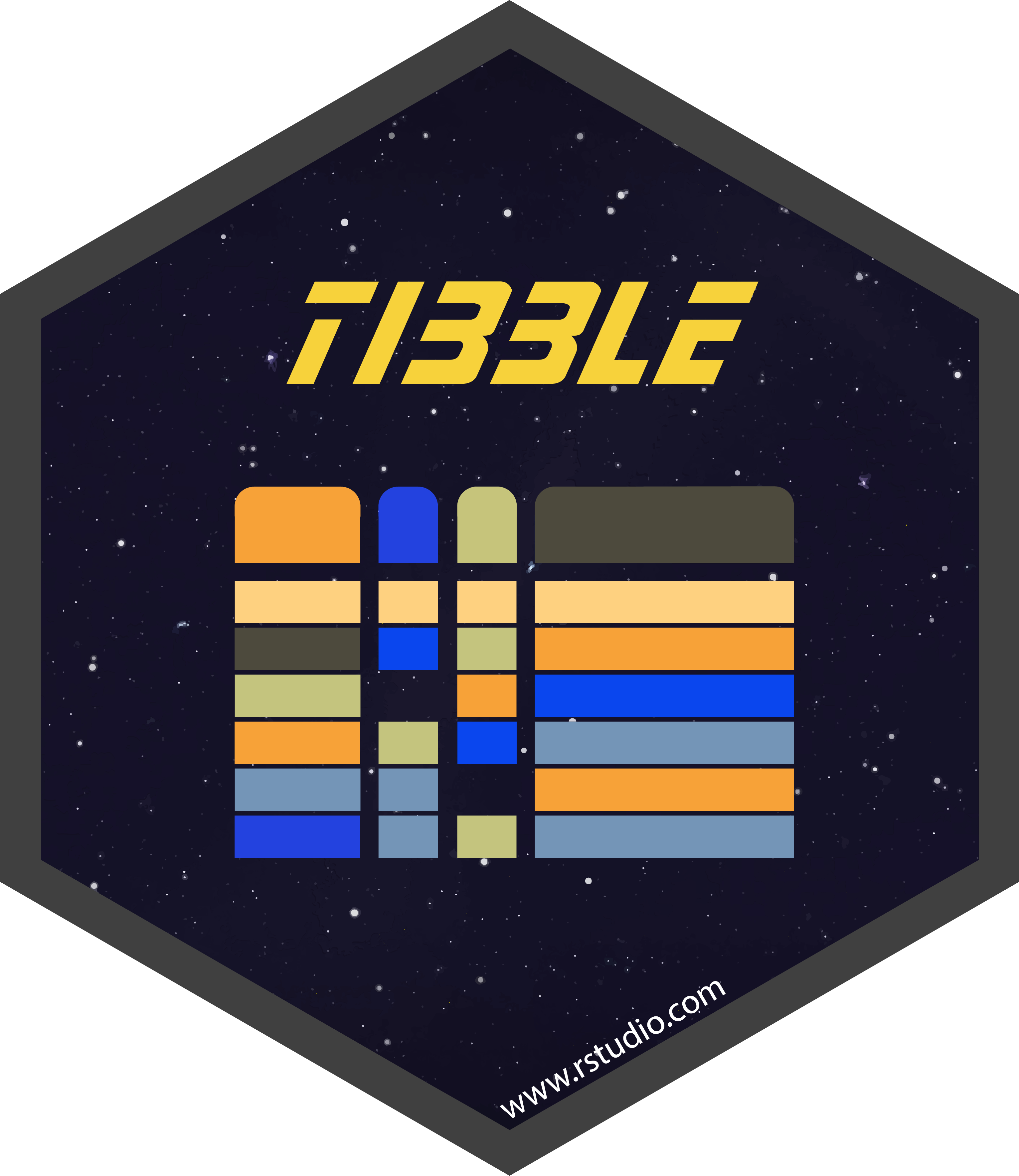Tibbles
Prerequisites

Here we’ll explore the TIBBLE package
suppressWarnings(library(tidyverse))“modern reimagining of the data.frame […] that are lazy and surly: they do less (i.e. they don’t change variable names or types, and don’t do partial matching) and complain more (e.g. when a variable does not exist). This forces you to confront problems earlier, typically leading to cleaner, more expressive code.”
Creating tibbles
Most other R packages use regular data frames, so you might want to
coerce a data frame to a tibble. You can do that with
as_tibble():
as_tibble(iris)## # A tibble: 150 × 5
## Sepal.Length Sepal.Width Petal.Length Petal.Width Species
## <dbl> <dbl> <dbl> <dbl> <fct>
## 1 5.1 3.5 1.4 0.2 setosa
## 2 4.9 3 1.4 0.2 setosa
## 3 4.7 3.2 1.3 0.2 setosa
## 4 4.6 3.1 1.5 0.2 setosa
## 5 5 3.6 1.4 0.2 setosa
## 6 5.4 3.9 1.7 0.4 setosa
## 7 4.6 3.4 1.4 0.3 setosa
## 8 5 3.4 1.5 0.2 setosa
## 9 4.4 2.9 1.4 0.2 setosa
## 10 4.9 3.1 1.5 0.1 setosa
## # … with 140 more rowsYou can create a new tibble from individual vectors with
tibble().
tibble() will automatically recycle inputs of length 1,
and allows you to refer to variables that you just created, as shown
below.
tibble(
x = 1:5,
y = 1,
z = x ^ 2 + y
)## # A tibble: 5 × 3
## x y z
## <int> <dbl> <dbl>
## 1 1 1 2
## 2 2 1 5
## 3 3 1 10
## 4 4 1 17
## 5 5 1 26If you’re already familiar with data.frame(),

tibble()does much less:
it never changes the type of the inputs (e.g. it never converts strings to factors!);
it never changes the names of variables;
it never creates row names.
tb <- tibble(
`:)` = "smile",
` ` = "space",
`2000` = "number"
)
tb## # A tibble: 1 × 3
## `:)` ` ` `2000`
## <chr> <chr> <chr>
## 1 smile space numberTibble vs data.frame
There are two main differences in the usage of a
tibble() vs. a classic data.frame():

printing and subsetting.
1. Printing
Tibbles have a prefined print method that shows only the first 10 rows, and all the columns that fit on screen.
In addition to its name, each column reports its
type, a nice feature borrowed from str():
tibble(
a = lubridate::now() + runif(1e3) * 86400,
b = lubridate::today() + runif(1e3) * 30,
c = 1:1e3,
d = runif(1e3),
e = sample(letters, 1e3, replace = TRUE)
)## # A tibble: 1,000 × 5
## a b c d e
## <dttm> <date> <int> <dbl> <chr>
## 1 2023-02-10 05:10:22 2023-02-28 1 0.236 a
## 2 2023-02-10 10:32:21 2023-02-16 2 0.958 o
## 3 2023-02-10 00:29:15 2023-02-16 3 0.0447 o
## 4 2023-02-10 03:28:00 2023-02-15 4 0.981 i
## 5 2023-02-09 19:10:10 2023-03-03 5 0.295 u
## 6 2023-02-10 04:33:31 2023-02-13 6 0.289 p
## 7 2023-02-09 22:48:00 2023-02-15 7 0.352 b
## 8 2023-02-10 07:10:40 2023-02-15 8 0.502 l
## 9 2023-02-10 06:04:49 2023-03-01 9 0.776 l
## 10 2023-02-10 13:25:36 2023-03-07 10 0.565 i
## # … with 990 more rowsFirst, you can explicitly print() the data frame and
control the number of rows (n) and the width
of the display. width = Inf will display all columns:
nycflights13::flights %>%
print(n = 10, width = Inf)You can control the default print behaviour by setting options:
options(tibble.print_max = n, tibble.print_min = m): if more thanmrows, print onlynrows. Useoptions(dplyr.print_min = Inf)to always show all rows.Use
options(tibble.width = Inf)to always print all columns, regardless of the width of the screen.
2. Subsetting
If you want to pull out a single variable, you need some new tools,
$ and [[.
[[ can extract by name or position; $ only
extracts by name but is a little less typing.
df <- tibble(
x = runif(5),
y = rnorm(5)
)
# Extract by name
df$x## [1] 0.6065414 0.6835919 0.9006848 0.3854084 0.9889426df[["x"]]## [1] 0.6065414 0.6835919 0.9006848 0.3854084 0.9889426# Extract by position
df[[1]]## [1] 0.6065414 0.6835919 0.9006848 0.3854084 0.9889426To use these in a pipe, you’ll need to use the special placeholder
.:
# Extract in pipe
df %>% .$x## [1] 0.6065414 0.6835919 0.9006848 0.3854084 0.9889426df %>% .[["x"]]## [1] 0.6065414 0.6835919 0.9006848 0.3854084 0.9889426Compared to a data.frame,

tibbles are more strict: they never do partial matching
# Partial matching
d = data.frame( alpha= runif(10), beta=runif(10))
d$al## [1] 0.6276676 0.3800857 0.2967158 0.8523114 0.5388956 0.8361498 0.8964996 0.8116371
## [9] 0.3043738 0.2367873# surly tibble
t = tibble( alpha= runif(10), beta=runif(10))
t$al## Warning: Unknown or uninitialised column: `al`.## NULLand they will generate a warning if the column you are trying to access does not exist.
Interacting with older code
Some older functions don’t work with tibbles. If you encounter one of
these functions, use as.data.frame() to turn a tibble back
to a data.frame:
class(as.data.frame(tb))## [1] "data.frame"A work by Matteo Cereda and Fabio Iannelli